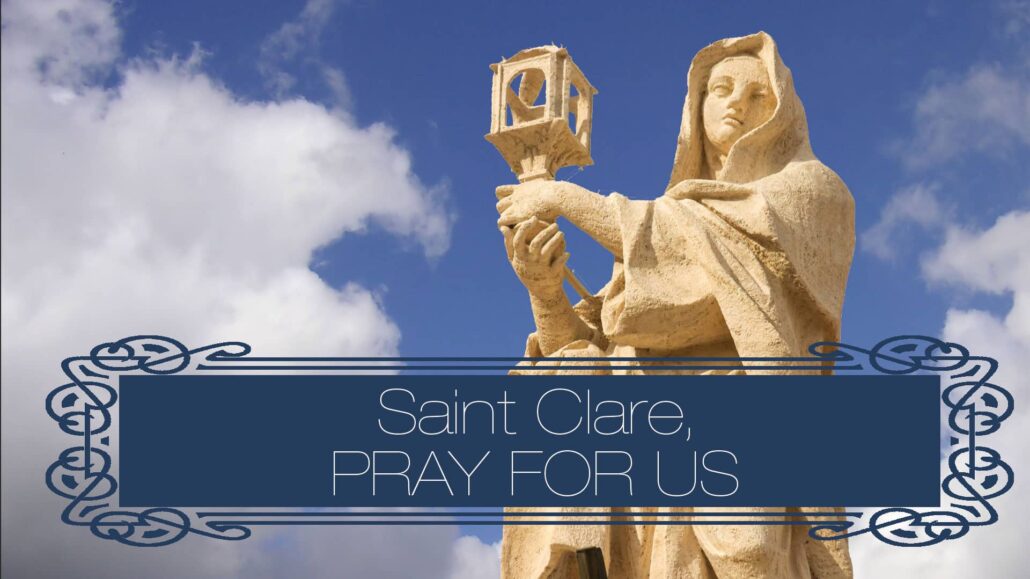It was time for Clare to marry.
She was getting older and the negotiations for her betrothal heightened. One by one available men approached Clare’s father and uncle for Clare’s hand in marriage. While the men were preoccupied with negotiations, Clare sneaked out of the house to go listen to the traveling friar, Francis of Assisi. When he spoke, it was as if he was speaking directly to her. His ideas were so much like her own. Soon after, they met on several occasions to discuss the Gospels and their beliefs. The two were of one mind.
In the dark of night on Palm Sunday 1212, just before Clare would be forced to accept a marriage proposal, the eighteen-year-old sneaked past the guards at her house and met Saint Francis and some other friars at the church of Santa Maria degli Angeli. She had given her fine gowns and entire dowry to the needy. Dressed in sackcloth and the gray robes of the friars, Clare and Francis stepped onto the altar. Under candlelight, the brothers encircled them and prayed as Francis cut Clare’s long silken hair to symbolize her entry into religious life. Immediately, she was taken to the safety of the Convent of St. Paul.
Once her family realized her deception, the armed guards charged into the church to reclaim her. She grasped the altar cloths and clung tightly so the guards could not remove her.
Finally, she lifted her veil and uncovered her shorn hair. At that, the family realized she would never marry. They acquiesced and three weeks later Clare’s younger sister followed a similar path. Francis’ vision was to walk in the way of the Lord.
In Luke’s Gospel Jesus sent the apostles to proclaim the kingdom of God and to heal, commanding, “Take nothing for your journey, no staff, nor bag, nor bread, nor money—not even an extra tunic. Whatever house you enter, stay there and leave from there” (Luke 9:3). This passage summarizes the Franciscan philosophy. It was very important to Francis to fully live these ideals. As he and his friars went forth preaching, he urged Clare to officially live under the rule of Saint Benedict but in practice to live the ideals she and Francis discussed.
Clare and her followers lived a life of total poverty in their convent at the Church of San Damiano. Shoes and beds were not on the list of necessities. They only ate food found in their backyard garden or given to them as a donation. They spent their days in quiet prayer and humble service. The nuns did not complain about the hardships; they welcomed them.
Pope Gregory IX, however, was concerned with the idea of absolute poverty. He seemed to think the idea was a bit naïve and was afraid someone might take advantage of the nuns. When the pope was a cardinal, he set up a rule that allowed the nuns to live in poverty while still maintaining some property. While this was close to the ideals Clare and Francis professed, it still missed the mark. Time and again, Clare approached the pope and asked for the privilege of poverty but was denied.
In 1226 Francis died. Many of his followers continued to adhere to his strict gospel lifestyle; some, however, began to loosen the guidelines. Eventually, a glorious cathedral was built in Saint Francis’ name. As beautiful as it was, he never would have granted such extravagance. Clare could see how easily people were swayed into easing the restrictions. She did not want that for her convent. She continued her requests to the pope for a rule that followed the vision of Saint Francis.
Clare was so convinced Francis’ vision was the path to God that she would not accept any substitute.
There were many new religious groups forming in the thirteenth century. If the church did not recognize them officially, the group ran the risk of being labeled as heretics. They could be excommunicated and no longer able to receive the sacraments. Every time Clare sent a letter to the pope asking to follow a guideline different than other religious groups, she ran the risk of shutting herself and her sisters off from the church. The pope kept writing new rules to try to appease Clare but still provide for her convent in dire times. Each time Clare rejected the proposals.
Eventually, she took it upon herself to write her own set of rules for papal approval. Finally, two days before her death in 1253, she received a papal bull granting her request. As she lay on her deathbed, she repeatedly kissed the paper granting her request. Now she knew Francis’ vision would live on.









3 thoughts on “St. Clare of Assisi: A Path of Her Own”
Take, Lord, and receive all my liberty, my memory, my understanding, and all my will, all that I have and possess. You have given them to me; to you, O Lord, I restore them; all things are yours, dispose of them according to your will. Give me your love and your grace, for this is enough for me.” (Prayer of Ignatius of Loyola, 1491-1556)
When a woman finds herself downsizing to fit in space that would make a monastic cell look opulent — having Clare of Assisi as accompaniment for the 4th quarter of life is deeply comforting. Clare, survived Francis by many decades. As do many women once partnered for a purpose, for a mission. Clare was completely cloistered though it might be called homebound, or assisted living today. Clare through Prayer of the Heart held a relevancy through engagement that could not be taken from her. Her “how” of bearing witness as an elder is one to seek out as one would find a formator for those deeply hidden years to come.
In 8 years, 71.5 million in the US alone will be over 65 and entering the Palm Sunday of the journey.
How wonderful — to enter into the Incarnation Season — with Clare! Her celebration of the Body of Christ still echoes among us today. May we too come to pray as she did at her homecoming —
“Go securely and in peace,
my blessed soul.
The One who created you
and made you holy
has always loved you tenderly
as a mother her dear child.”
thank you st clare for prayers answered
publication promised.
Pray whether you believe or not and promise to publish or circulate. Ask for 3 favours: 1 business and 2 impossible. Say 9 Hail Marys and the following prayer for 9 nights in front of a lighted candle: God of mercy you inspired St. Claire w/ the love of poverty by the help of her prayers. May we follow Christ in poverty of spirit and come to the joyful vision of your glory in the kingdom of heaven. We ask this through our Lord Jesus Christ your son who lives and reigns with the Holy Spirit, One God forever and ever. Amen
Comments are closed.